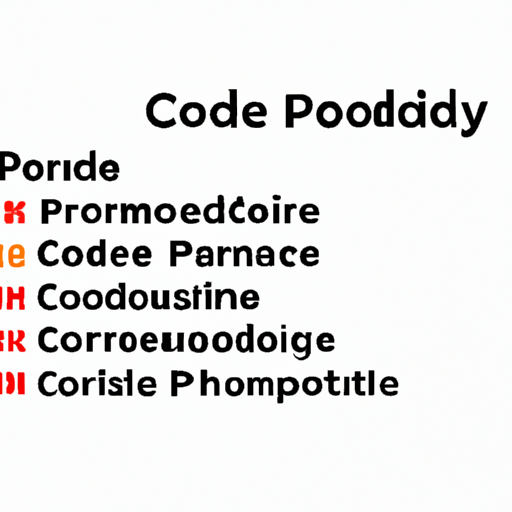

Product standards for compiling code refer to the set of guidelines and requirements that ensure the quality, efficiency, and compatibility of compiled software. These standards are crucial for developers, as they help in producing reliable and maintainable code. In this article, we will explore the various product standards for compiling code, including coding conventions, performance optimization, compatibility, and security considerations.

2. Performance Optimization: Efficient code is essential for optimal software performance. Product standards for compiling code include techniques and best practices to improve the speed and efficiency of the compiled software. This may involve optimizing algorithms, reducing memory usage, minimizing disk I/O operations, and utilizing compiler optimizations. Performance profiling tools can also be used to identify bottlenecks and areas for improvement.
3. Compatibility: Compatibility is a critical aspect of compiled software. Product standards for compiling code ensure that the compiled software works correctly across different platforms, operating systems, and hardware configurations. This involves adhering to platform-specific guidelines, using cross-platform libraries and frameworks, and performing thorough testing on various environments.
4. Security Considerations: Security is of utmost importance in today's digital landscape. Product standards for compiling code include measures to ensure the security of the compiled software. This may involve following secure coding practices, such as input validation, proper error handling, and protection against common vulnerabilities like buffer overflows and SQL injections. Additionally, code reviews and security testing can help identify and fix potential security flaws.
5. Documentation: Comprehensive documentation is essential for maintaining and understanding compiled code. Product standards for compiling code include requirements for documenting the codebase, including inline comments, function and class descriptions, and high-level system documentation. Well-documented code helps future developers understand the codebase, facilitates collaboration, and eases the process of debugging and maintaining the software.
6. Version Control: Version control is crucial for managing code changes and collaboration among developers. Product standards for compiling code include the use of version control systems, such as Git or Subversion, to track changes, manage branches, and facilitate code reviews. Following version control best practices ensures that code changes are properly tracked, reviewed, and integrated into the software.
In conclusion, product standards for compiling code encompass a range of guidelines and requirements that ensure the quality, efficiency, compatibility, and security of compiled software. By adhering to coding conventions, optimizing performance, ensuring compatibility, considering security, documenting the codebase, and utilizing version control, developers can produce reliable and maintainable code. These standards play a crucial role in the development process, ultimately leading to the creation of high-quality software.
Product standards for compiling code refer to the set of guidelines and requirements that ensure the quality, efficiency, and compatibility of compiled software. These standards are crucial for developers, as they help in producing reliable and maintainable code. In this article, we will explore the various product standards for compiling code, including coding conventions, performance optimization, compatibility, and security considerations.

2. Performance Optimization: Efficient code is essential for optimal software performance. Product standards for compiling code include techniques and best practices to improve the speed and efficiency of the compiled software. This may involve optimizing algorithms, reducing memory usage, minimizing disk I/O operations, and utilizing compiler optimizations. Performance profiling tools can also be used to identify bottlenecks and areas for improvement.
3. Compatibility: Compatibility is a critical aspect of compiled software. Product standards for compiling code ensure that the compiled software works correctly across different platforms, operating systems, and hardware configurations. This involves adhering to platform-specific guidelines, using cross-platform libraries and frameworks, and performing thorough testing on various environments.
4. Security Considerations: Security is of utmost importance in today's digital landscape. Product standards for compiling code include measures to ensure the security of the compiled software. This may involve following secure coding practices, such as input validation, proper error handling, and protection against common vulnerabilities like buffer overflows and SQL injections. Additionally, code reviews and security testing can help identify and fix potential security flaws.
5. Documentation: Comprehensive documentation is essential for maintaining and understanding compiled code. Product standards for compiling code include requirements for documenting the codebase, including inline comments, function and class descriptions, and high-level system documentation. Well-documented code helps future developers understand the codebase, facilitates collaboration, and eases the process of debugging and maintaining the software.
6. Version Control: Version control is crucial for managing code changes and collaboration among developers. Product standards for compiling code include the use of version control systems, such as Git or Subversion, to track changes, manage branches, and facilitate code reviews. Following version control best practices ensures that code changes are properly tracked, reviewed, and integrated into the software.
In conclusion, product standards for compiling code encompass a range of guidelines and requirements that ensure the quality, efficiency, compatibility, and security of compiled software. By adhering to coding conventions, optimizing performance, ensuring compatibility, considering security, documenting the codebase, and utilizing version control, developers can produce reliable and maintainable code. These standards play a crucial role in the development process, ultimately leading to the creation of high-quality software.